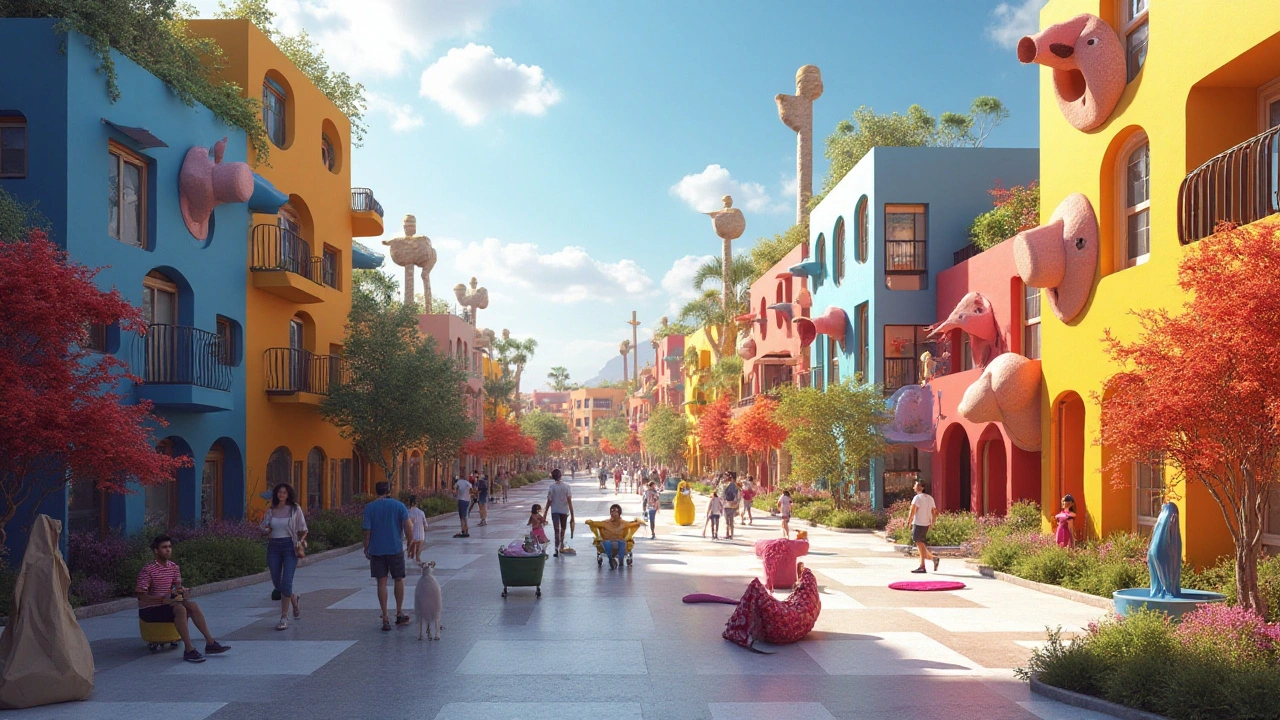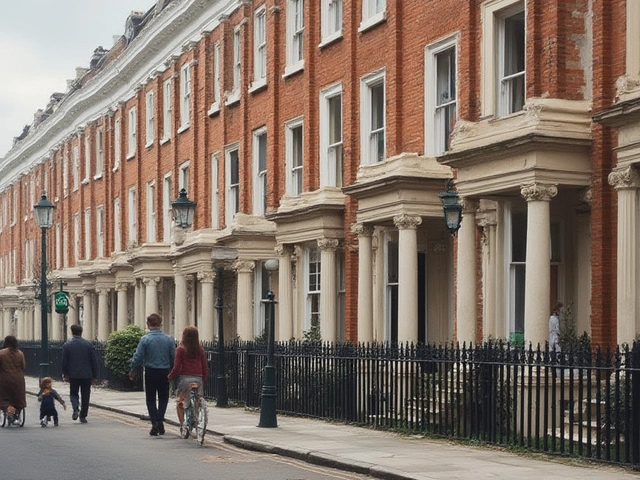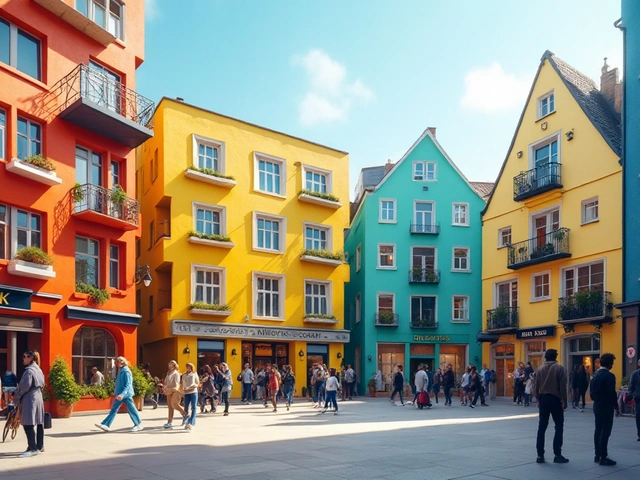Postmodern architecture is a visual feast, offering viewers a mix of styles, playful forms, and vibrant colors. This movement emerged in the late 20th century as a reaction to the rigid rules of modernism. Architects like Michael Graves and Robert Venturi spearheaded the movement, pushing for more expressive and diverse structures.
Defining features of postmodern architecture include eclectic design elements, historical references, and a blend of new and old. These buildings often mix traditional and contemporary materials, resulting in unique, eye-catching facades.
Take, for instance, the Vanna Venturi House, which combines simplicity with historical allusions, creating an intriguing space that's both familiar and unexpected. Similarly, the Walt Disney Concert Hall in Los Angeles stands out with its dynamic, flowing forms.
To incorporate postmodern elements into your own projects, start by embracing contrast and complexity. Use a mix of materials, play with shapes and patterns, and don't shy away from color. The aim is to create spaces that are not just functional, but also visually stimulating and rich in meaning.
- Roots of Postmodern Architecture
- Defining Features
- Notable Examples Worldwide
- Incorporating Postmodern Elements
Roots of Postmodern Architecture
Postmodern architecture began to take shape in the late 1960s to early 1970s as a counter-movement to modernism, which many believed had become too standardized and impersonal. The modernist focus on minimalism and functionality had started to feel cold and uninviting to some. There was a desire to bring back the human element, and architects like Robert Venturi and Michael Graves answered this call. They championed designs that were not only functional but also playful and expressive.
One of the pivotal moments for postmodernism was the publication of Robert Venturi's book, Complexity and Contradiction in Architecture, in 1966. Venturi argued against the minimalist ethos of “less is more” with his now-famous phrase, “less is a bore.” He advocated for a more inclusive approach to design, incorporating elements from both high and low culture, blending historical references with contemporary features. This philosophy resonated with many architects who were looking for a way to break free from the constraints of modernism.
Interestingly, postmodern architects often borrowed from various historical styles, not to replicate them but to reinterpret them in a contemporary context. This eclectic approach allowed for a rich and diverse visual language. Iconic structures like the AT&T Building in New York, designed by Philip Johnson, exemplify this mix of old and new. Johnson's building features a Chippendale-inspired broken pediment at the top, a clear nod to classic design but executed in a modern skyscraper.
The movement wasn't confined to the West. Postmodernism found a global presence, influencing architecture in various countries. In Japan, architects like Kengo Kuma embraced the playful and eclectic nature of postmodern design, creating buildings that felt both innovative and culturally rooted. In the early 1980s, the Portland Building by Michael Graves further cemented postmodernism's standing. Its colorful and whimsical design was a stark contrast to the more somber modernist buildings that surrounded it.
While postmodern architecture often faced criticism for being too impractical or overly decorative, it brought a much-needed sense of freedom and creativity. It allowed architects to experiment with form, color, and materials in ways that were previously considered taboo. The results were buildings that not only served their purpose but also told a story, connected with their users, and engaged with their surroundings in a meaningful way.
As noted by architecture critic Charles Jencks, who wrote extensively on the subject, "Postmodernism can be seen as a reaction to the failures of modernism, but also as an attempt to enrich architectural language." This enrichment came from breaking away from the singular narrative of modernism and embracing a more complex and layered approach to design.
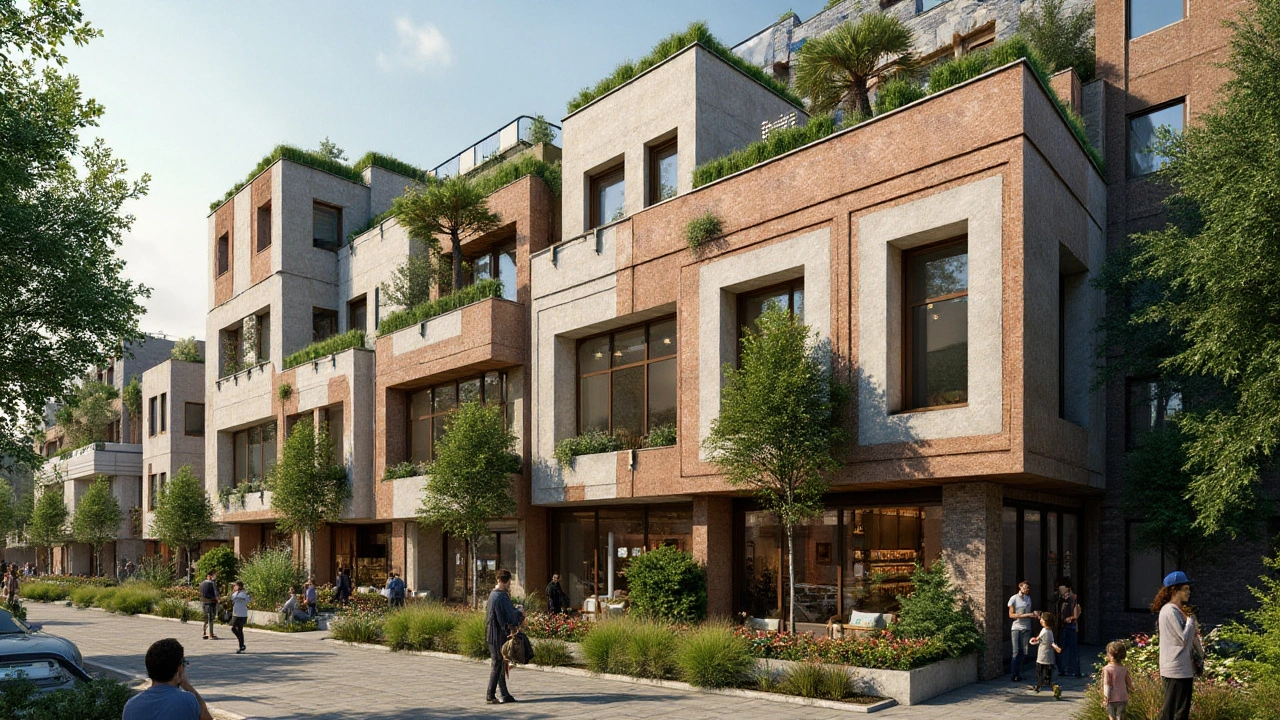
Defining Features
Postmodern architecture stands out due to its combination of different styles, historical references, and playful forms. One of the key defining features is eclecticism, where architects blend multiple elements from diverse architectural traditions. This results in a texture-rich, layered aesthetic that catches the eye. Buildings often borrow from classical, Gothic, and Baroque styles, incorporating arches, columns, and intricate details alongside modern materials.
Another hallmark of postmodern architecture is its use of color. Unlike modernist buildings, which usually lean towards neutral palettes, postmodern structures embrace bold, vibrant hues. This use of lively color schemes helps to break the monotony of urban landscapes and create more engaging surroundings. Importantly, colors are not just applied superficially; they are integral to the design and flow of these architectural masterpieces.
Historical references are omnipresent in postmodern design, with architects often reinterpreting and juxtaposing historical motifs. For example, referencing the Pantheon in Rome, the AT&T Building in New York (now known as the Sony Building) features a broken pediment at its top. This blend of past and present makes each structure unique yet familiar.
Materials also play a significant role in postmodern architecture. While modernist buildings frequently use glass and steel, postmodern ones incorporate a variety of materials such as brick, stone, and even terra cotta. This mix is not only about aesthetics but also about functionality. Achieving a balance between traditional and contemporary materials allows for both durability and visual appeal. In some cases, the deliberate use of mismatched materials adds a sense of whimsy to the structure.
“Less is a bore,” famously said by Robert Venturi, captures the essence of postmodern architecture perfectly.
Functional ornamentation is another critical feature. Unlike modern architectures’ emphasis on minimalism, postmodern buildings often include decorative elements that enhance functionality. These might include exaggerated eaves for better rainwater drainage or stylish yet practical sunscreens. This duality helps make buildings not only visually interesting but also highly functional and user-friendly.
Symbolism also plays a large role in postmodern designs. Architects frequently embed symbolic meanings into their structures, conveying messages or reflecting cultural narratives. This gives postmodern buildings a storytelling element that goes beyond mere aesthetics. For instance, the Portland Building by Michael Graves incorporates small-scale windows and patterned surfaces, resembling a modern interpretation of ancient Greek friezes and conveying a message about democracy and civic life.
Lastly, the visual complexity of postmodern architecture should be noted. Unlike its modernist counterpart, which relies on clean lines and simplicity, postmodern architecture is intricate and detailed. The goal is to engage viewers visually and intellectually, encouraging them to explore the building from different angles and perspectives. This layered complexity can make even a simple structure appear rich and multifaceted.

Notable Examples Worldwide
When discussing notable examples of postmodern architecture around the globe, there are several structures that truly stand out for their innovative designs and striking visuals. One of the earliest and most significant is the Piazza d'Italia in New Orleans, designed by Charles Moore in the 1970s. This urban public plaza features a bold mix of historical references, neon lighting, and quirky columns. It's a fun and engaging space that invites visitors to explore and discover its unique elements.
In 1986, Frank Gehry's design for the Vitra Design Museum in Germany unveiled another milestone in the world of postmodern architecture. The building’s deconstructed forms and dynamic lines created a stylistic signature that Gehry would become known for. The combination of industrial materials like corrugated metal with organic shapes was startlingly innovative and remains a highlight of Gehry's illustrious career.
Perhaps no building better exemplifies postmodernism’s playful side than the Walt Disney Concert Hall in Los Angeles. Designed by Gehry as well, this concert hall is celebrated for its sweeping, fluid lines that almost seem to dance. The stainless steel facade reflects the Southern California sun, making the building appear as a radiant sculpture. Visitors often find themselves mesmerized by its exterior, even before stepping inside to enjoy the stellar acoustics.
Heading to Europe, the Groninger Museum in the Netherlands is another jewel in the postmodern crown. Created by the Italian designer Alessandro Mendini, the museum veers away from traditional symmetry and instead offers a collection of brightly colored, fragmented forms. It’s a place where modern art and innovative architecture intersect, making every visit a new visual adventure.
The Vanna Venturi House in Philadelphia, designed by Robert Venturi, is also an important case study. Despite its modest size, the building is packed with historical references and playful design cues. This residence challenges conventional architectural wisdom and showcases Venturi’s belief that “less is a bore.”
“The ultimate irony of architecture is the tension between permanence and ephemerality,” noted architect Philip Johnson, one of the leading voices in the postmodern movement.
In Tokyo, the Center Pompidou stands as a revolutionary example of postmodern aesthetics. Conceived by Renzo Piano and Richard Rogers, this cultural hub turns architecture inside out, exposing the building's structural elements and mechanical systems. The vibrant color-coding of pipes and ducts adds a layer of whimsy and complexity. It's a visual feast that reveals the building's inner workings to the passerby, making it as much a teaching tool as an architectural masterpiece.
Dubai's Burj Al Arab also adds to the global tapestry of postmodernism. Designed by Tom Wright, it is one of the tallest hotels in the world, its shape inspired by a ship's sail. The structure combines futuristic design with luxurious amenities, making it a symbol of opulence and modernity.
While these examples encapsulate the diversity and creativity of postmodern architecture, they also serve as touchstones for its principles. Each structure, in its unique way, breaks away from the norms, blending past and present to create something wholly original. Whether you're an architect, a student, or simply an admirer of innovative design, there's much to learn and appreciate in these remarkable buildings.
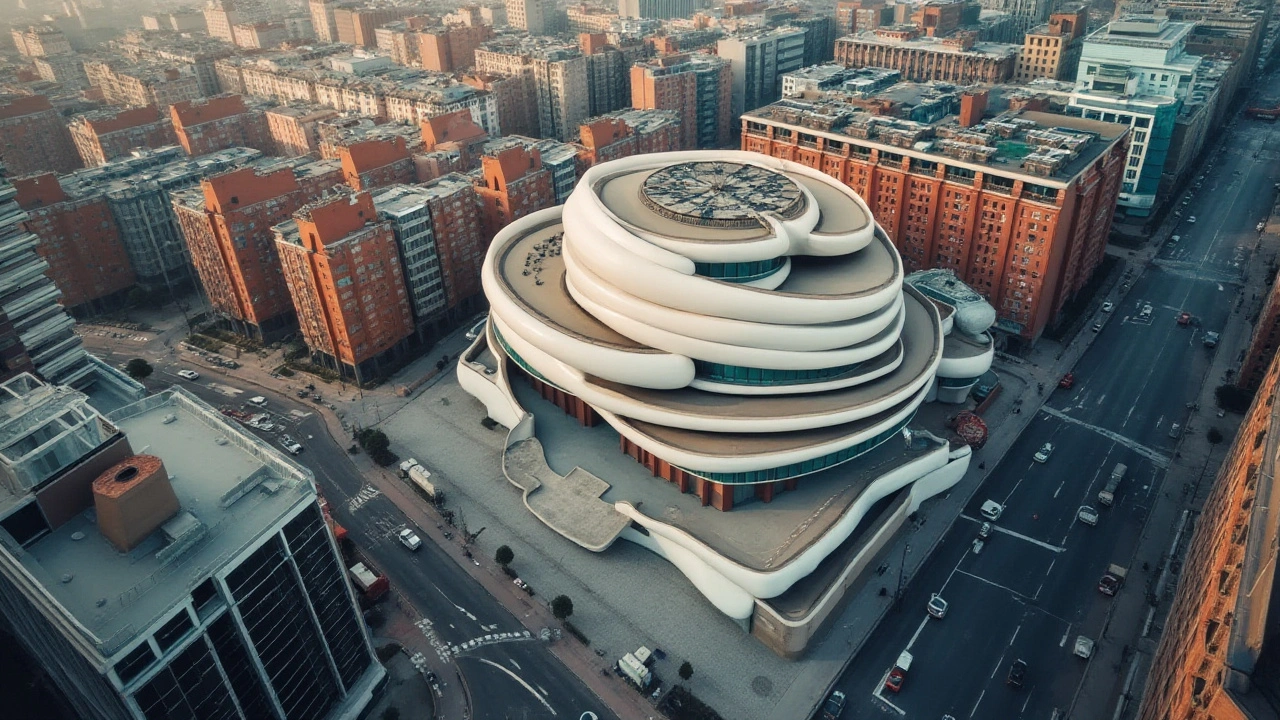
Incorporating Postmodern Elements
To successfully incorporate postmodern architecture into your projects, it's important to understand the blend of playful designs and historical references. Start by embracing contrast. For instance, use both traditional and contemporary materials to create an engaging visual narrative. It's the combination of the past and present that gives postmodern design its unique character.
Consider playing with shapes and patterns. Postmodern architecture often sidesteps the usual rectangular forms in favor of more dynamic and unexpected shapes. This can mean anything from rounded windows to asymmetrical facades. The goal is to offer a fresh perspective, something that makes observers pause and reflect.
Another key element is color. While modern architecture might stick to monochromes, postmodern architecture is not afraid to use bold, vibrant colors. Think about using unexpected color combinations that bring a sense of whimsy and joy to the building. The Piazza d'Italia in New Orleans is a great example, where bright colors and playful forms coexist harmoniously.
Eclectic ornamentation is also essential. Unlike the minimalist approach of modernism, postmodern architecture often celebrates ornamentation. This means incorporating decorative elements that might even seem redundant from a functional viewpoint, but they add layers of meaning and visual interest. As Robert Venturi famously said, "Less is a bore."
The quote highlights the importance of embracing complexity and the ornamental spirit that defines postmodern architecture.
Functionality should not be compromised, however. While the exterior invites curiosity and awe, the interior must remain practical and usable. Think about how each design decision impacts the user experience. Can a playful element also serve a functional purpose? For example, a spiraling staircase can become a central piece of art in an otherwise minimalist room.
If you're considering a renovation, don't hesitate to mix old and new elements. Re-purpose historical artifacts alongside cutting-edge technology. It's all about finding a balance that tells a story. In residential projects, blending vintage furniture with modern appliances creates a rich, layered aesthetic.
Lastly, think about using environmentally sustainable materials. Many postmodern architects are now focusing on green architecture, combining the eclectic styles with eco-friendly building practices. This ensures a lasting impact on both the environment and the users of the space.
Postmodern architecture is all about creating spaces that stimulate the senses and engage the mind. With these tips, you can bring elements of this bold and original style into your own architectural endeavors.

